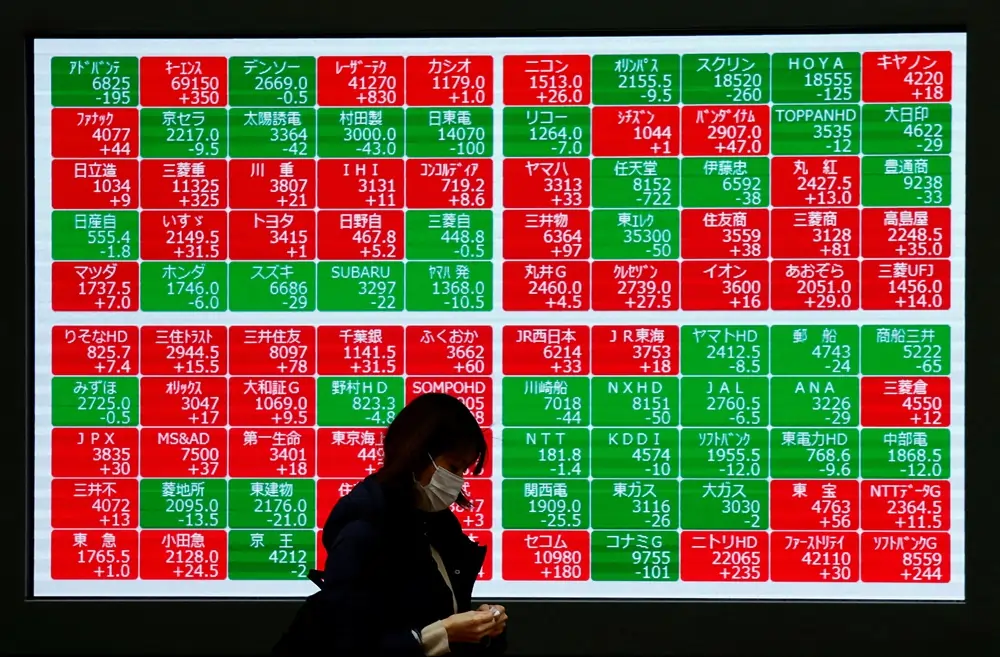
Stocks regain some ground, bonds steady after rate angst sell-off
By Samuel Indyk and Rae Wee
LONDON (Reuters) -European stocks edged higher on Thursday as bonds regained some ground after a sell-off the day before on bets that global interest rates would stay high due to sticky inflation.
The dollar softened as U.S. Treasury yields slipped back, while metals and energy prices came under pressure.
The latest slowdown in the global risk rally has come on the back of data pointing to lingering inflationary pressures across major economies and a flood of bond sales lifting yields.
“There are two forces colliding here,” said Ben Laidler, global markets strategist at eToro.
“It’s being driven by the very heavy government bond issuance and markets that are still afraid of interest rates staying higher for longer and sticky inflation.”
But for now, bond markets have steadied, which has supported equity markets in Europe.
The pan-European STOXX 600 rose just under 0.4%, having fallen over 1% on Wednesday, its biggest one-day drop since mid-April.
Germany’s DAX, France’s CAC and Britain’s FTSE 100 eked out gains of 0.1%-0.4%.
Wall Street futures were soft, with S&P and Nasdaq eminis both shedding around 0.3%.
Germany’s 10-year bund yield, which earlier touched a six-month high at 2.687%, was little changed at 2.685%. Bond yields move inversely to prices.
Data on Wednesday showed German inflation rose slightly more than forecast to 2.8% in May, ahead of the closely watched wider euro zone bloc’s reading on Friday.
A higher-than-forecast inflation reading on Friday is unlikely to derail the European Central Bank from lowering borrowing costs next week but could have implications for future policy moves.
“The stickiness of services inflation remains a source of concern,” eToro’s Laidler said.
“It’s not enough to stop the ECB from cutting next week but it does call into question how quickly and how far they go after that.”
Markets are pricing in around 60 basis points (bps) of easing from the ECB this year, implying two quarter-point rate cuts and around a 40% chance of a third.
The main highlight of the week for markets, however, is Friday’s U.S. core personal consumption expenditures (PCE) price index report – the Fed’s preferred measure of inflation. Expectations are for it to hold steady on a monthly basis.
“If we look at data that has led us to this point, I have a hard time believing a softer-than-expected PCE report will arrive on Friday,” said Matt Simpson, senior market analyst at City Index.
“From this perspective, PCE not ticking higher could be a welcome surprise. But should it heat up further from sticky levels, appetite for risk will be taken out the back for a good kicking.”
U.S. Treasury yields dipped on Thursday, having risen over 8 bps the day before, in part due to a weak debt auction. The benchmark 10-year yield was last at 4.596%, while the two-year yield stood at 4.964%.
Japanese government bond (JGB) yields notched fresh multi-year peaks on growing expectations that further rate hikes from the Bank of Japan could be imminent.
The 10-year JGB yield peaked at 1.1% in early Asia trade, its highest since July 2011.
DOLLAR GIVES BACK SOME GAINS
In the currency market, the dollar softened, having earlier knocked the euro to an over two-week low of $1.07885.
The yen last stood at 156.82 per dollar, having slid to a four-week low of 157.715 in the previous session.
The dollar index, which measures the currency against six others including the euro and yen, was down 0.2%, after a 0.5% jump the day before.
Oil prices lost ground on worries over weak U.S. gasoline demand and higher-for-longer interest rates.
Brent fell 0.5% to $83.14 per barrel while U.S. crude eased a similar amount to $78.87. [O/R]
Spot gold fell 0.1% to $2,337 an ounce. [GOL/]
(Reporting by Samuel Indyk and Rae Wee; Editing by Nick Macfie and Mark Potter)


